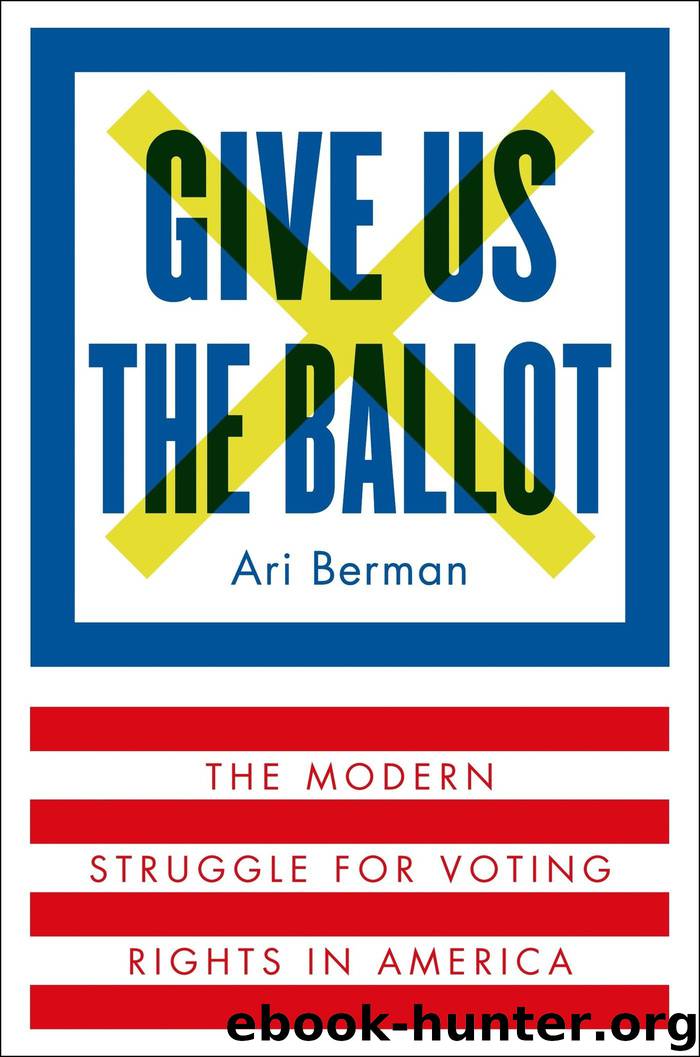Give Us the Ballot: The Modern Struggle for Voting Rights in America by Ari Berman

Author:Ari Berman [Berman, Ari]
Language: eng
Format: epub, mobi
Tags: History, United States, 20th Century, Political Science, Civil Rights, Political Process, Campaigns & Elections
ISBN: 0374158274
Google: TDMnBgAAQBAJ
Amazon: B00S54VUDY
Publisher: Macmillan
Published: 2015-08-04T04:00:00+00:00
8
THE COUNTERREVOLUTION (II)
On November 7, 2000, Willie Steen, a navy vet who served in the Persian Gulf during Desert Storm, went to cast his ballot for president at the St. Francis Episcopal Church in Tampa, Florida.
He brought his ten-year-old son, Willie, Jr., to the polls for the first time. They waited a half hour to reach a poll worker. When Steen gave the poll worker his name, she searched a list of registered voters in the precinct and told him, “You can’t vote. You’re a convicted felon.”
“You must be mistaken,” a shocked Steen replied. “I’ve never been arrested in my life.” He worked at a hospital, the Tampa Orthopedics Center, that wouldn’t employ anyone with a felony conviction.
The poll worker gave him a number to call at the board of elections, but no one picked up. The seventy-five people behind him in line grew antsy. Few would look him in the eye.
He left in embarrassment, struggling to explain to his son what had just happened. After fighting for his country abroad, he wasn’t able to exercise his most fundamental right at home. “I felt I was shafted,” Steen said. “I think there were a lot of things that weren’t done properly. My name was dragged through the mud.”
He later found out he’d been confused with a convict named Willie O’Steen, who had committed a felony between 1991 and 1993, when Steen was in the Persian Gulf. Little did Steen know that the same thing was happening to voters across the state of Florida, particularly to voters like him, who were African-American.
Before the election, Florida sent its sixty-seven county election supervisors a list of fifty-eight thousand alleged felons to purge from the voting rolls. Florida was one of eight states that prevented ex-felons from voting. Blacks made up only 15 percent of registered voters in the state, but 44 percent of those on the purge list, which turned out to be littered with errors.
Elsewhere in Tampa, Wallace McDonald was one of 3,258 alleged felons who received a letter from the Hillsborough County supervisor of elections, Pam Iorio, telling him he was ineligible to vote. In 1959, when he was twenty-three, McDonald fell asleep on a bench while waiting for a bus and was arrested for vagrancy. He was ordered to work on a municipal garbage truck for his sentence. He was fined thirty dollars when he walked off the job in protest.
But he’d never been accused of a felony until he received the state’s notification forty-one years later. “I could not believe it, after voting for all these years since the 50s, without a problem,” McDonald said. He hired a lawyer, who confirmed he was not a felon, but Iorio refused to reinstate him to the voter rolls.
In St. Petersburg, Floredia Walker showed up at her usual polling place at Pleasant Grove Church. She too appeared on the felon list and was told she couldn’t vote.
Walker worked for the department of corrections, where she was subject to background checks and, like Steen, couldn’t hold her job with a criminal record.
Download
Give Us the Ballot: The Modern Struggle for Voting Rights in America by Ari Berman.mobi
This site does not store any files on its server. We only index and link to content provided by other sites. Please contact the content providers to delete copyright contents if any and email us, we'll remove relevant links or contents immediately.
| Africa | Americas |
| Arctic & Antarctica | Asia |
| Australia & Oceania | Europe |
| Middle East | Russia |
| United States | World |
| Ancient Civilizations | Military |
| Historical Study & Educational Resources |
Cat's cradle by Kurt Vonnegut(15129)
Pimp by Iceberg Slim(14275)
4 3 2 1: A Novel by Paul Auster(12247)
Underground: A Human History of the Worlds Beneath Our Feet by Will Hunt(11992)
The Radium Girls by Kate Moore(11888)
Wiseguy by Nicholas Pileggi(5627)
Perfect Rhythm by Jae(5297)
American History Stories, Volume III (Yesterday's Classics) by Pratt Mara L(5234)
The Fire Next Time by James Baldwin(5217)
Paper Towns by Green John(5057)
Pale Blue Dot by Carl Sagan(4880)
A Higher Loyalty: Truth, Lies, and Leadership by James Comey(4817)
The Mayflower and the Pilgrims' New World by Nathaniel Philbrick(4393)
The Doomsday Machine by Daniel Ellsberg(4388)
Killers of the Flower Moon: The Osage Murders and the Birth of the FBI by David Grann(4363)
The Sympathizer by Viet Thanh Nguyen(4279)
Too Much and Not the Mood by Durga Chew-Bose(4247)
The Borden Murders by Sarah Miller(4211)
Sticky Fingers by Joe Hagan(4080)
